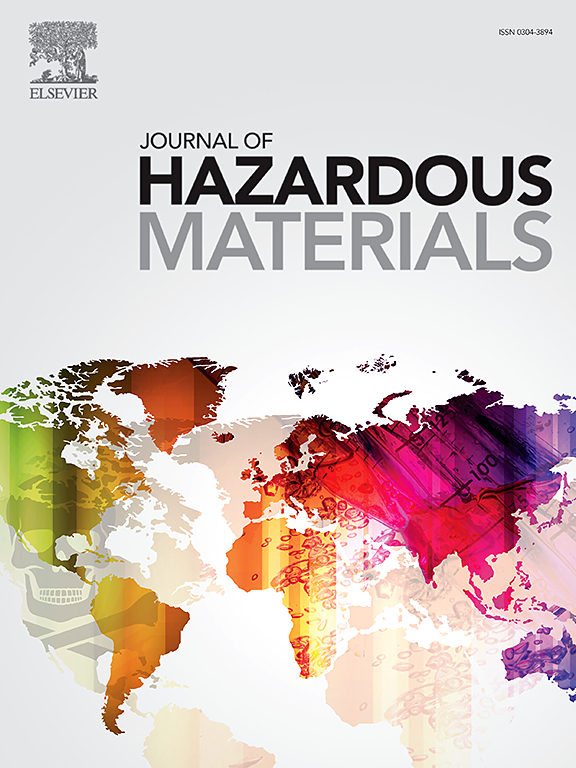稳定同位素探测和寡聚分型揭示有机磷农药对碳固定相关浮游细菌系的影响
IF 11.3
1区 环境科学与生态学
Q1 ENGINEERING, ENVIRONMENTAL
引用次数: 0
摘要
淡水浮游细菌群落在全球碳固定和能量交换中起着关键作用。然而,建立环境压力源如有机磷农药(OPPs)与生态功能(如碳固定相关微生物(CFMs))之间的直接联系仍然具有挑战性。本研究利用稳定同位素探测、高通量测序和寡分型分析,研究了四种OPPs -两种磷酸盐(敌敌畏、敌敌畏)和两种磷硫酸盐(敌敌畏、对硫磷)对浮游细菌群落的影响。确定了7个cfm。所有OPPs都显著降低了总生物量(从7.87×104到2.30-4.11×104细胞/mL),但刺激了CFMs的增殖。值得注意的是,与磷酸盐(23.85%-37.10%)相比,硫代盐诱导CFMs丰度的增加幅度更大(36.84%-57.18%,高于21.1%);p & lt;0.05)。主坐标分析(PCoA)表明,与磷酸盐相比,硫代磷酸酯对微生物群落和CFMs寡型结构的影响更大(p <;0.05)。方差划分分析(VPA)表明,农药类型是影响群落结构的主导因素。PICRUSt2预测表明,OPPs抑制了与能量代谢相关的氧化还原酶途径,同时激活了与微生物抗逆性相关的转移酶途径。硫代磷对64条途径的抑制作用和对208条途径的抑制作用远远超过对磷的抑制作用(抑制2条,增强22条),表明硫代磷对浮游细菌群落的影响比磷更重要。此外,暴露于OPPs减少了功能冗余,破坏了浮游细菌群落的稳定性,潜在地赋予cfm长期竞争优势,并增加了藻华风险。这些发现为了解水生系统中的活性cfm及其对各种opp的反应提供了新的见解,为管理有机磷农药污染提供了新的视角。本文章由计算机程序翻译,如有差异,请以英文原文为准。

Stable isotope probing and oligotyping reveal the impact of organophosphorus pesticides on the carbon fixation related bacterioplankton lineage
Freshwater bacterioplankton communities play a pivotal role in global carbon fixation and energy exchange. However, establishing direct linkages between environmental stressors like organophosphorus pesticides (OPPs) and the ecological functions, such as carbon-fixing related microorganisms (CFMs), remains challenging. This study investigated the effects of four OPPs — two phosphates (dichlorvos, monocrotophos) and two phosphorothioates (omethoate, parathion) — on bacterioplankton communities using stable isotope probing, high-throughput sequencing and oligotyping analysis. Seven CFMs were identified. All OPPs significantly reduced total biomass (from 7.87 ×104 to 2.30–4.11 ×104 cells/mL) but stimulated CFMs proliferation. Notably, phosphorothioates induced a greater increase in CFMs abundance (36.84 %–57.18 %, up from 21.1 %) compared to phosphates (23.85 %–37.10 %; p < 0.05). Principal coordinate analysis (PCoA) revealed that phosphorothioates exerted stronger effects on microbial community and CFMs oligotypes structure compared to phosphates (p < 0.05). Variance partitioning analysis (VPA) identified pesticide type as the dominant driver of community structure. PICRUSt2 prediction demonstrated that OPPs suppressed oxidoreductase pathways linked to energy metabolism while activating transferase pathways associated with microbial stress resistance. Phosphorothioates depleted 64 pathways and enhanced 208 pathways, far exceeding phosphate impacts (2 depleted, 22 enhanced), indicating the phosphorothioates played a more important role on bacterioplankton communities than phosphate. Additionally, OPPs exposure reduced functional redundancy and destabilized community stability in bacterioplankton, potentially granting CFMs a long-term competitive advantage and elevating algal bloom risks. These findings provide insights into active CFMs in aquatic systems and their responses to diverse OPPs, offering new perspectives for managing organophosphorus pesticide contamination.
求助全文
通过发布文献求助,成功后即可免费获取论文全文。
去求助
来源期刊

Journal of Hazardous Materials
工程技术-工程:环境
CiteScore
25.40
自引率
5.90%
发文量
3059
审稿时长
58 days
期刊介绍:
The Journal of Hazardous Materials serves as a global platform for promoting cutting-edge research in the field of Environmental Science and Engineering. Our publication features a wide range of articles, including full-length research papers, review articles, and perspectives, with the aim of enhancing our understanding of the dangers and risks associated with various materials concerning public health and the environment. It is important to note that the term "environmental contaminants" refers specifically to substances that pose hazardous effects through contamination, while excluding those that do not have such impacts on the environment or human health. Moreover, we emphasize the distinction between wastes and hazardous materials in order to provide further clarity on the scope of the journal. We have a keen interest in exploring specific compounds and microbial agents that have adverse effects on the environment.
 求助内容:
求助内容: 应助结果提醒方式:
应助结果提醒方式:


